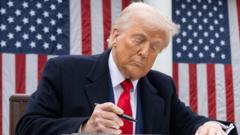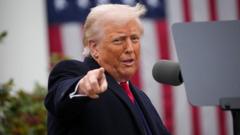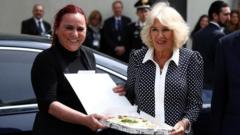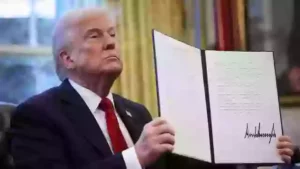The international landscape shifts as Moscow’s absence from President Trump's tariff list raises eyebrows in the West, reflecting the complexities of US-Russia relations amidst ongoing sanctions and trade dynamics.
Russia Snubbed in Trump's Tariff Plans: A Closer Look

Russia Snubbed in Trump's Tariff Plans: A Closer Look
US tariffs list omits Russia despite Western expectations, highlighting the impact of existing sanctions.
In a surprising turn of events, Russia has not been included in President Donald Trump's latest tariff list targeting US trade partners, a decision that local media outlets report has left many in the West disappointed. According to Axios, White House Press Secretary Karoline Leavitt explained that the omission is a result of existing US sanctions against Russia, which "preclude any meaningful trade." This means that nations like Cuba, Belarus, and North Korea were also absent from the list, despite their own limited trade with the U.S.
Interestingly, even countries with significantly lower trade volumes with the U.S., such as Syria, found themselves on the tariff list, which brings further scrutiny to the rationale behind the decision. Since Russia's full-scale invasion of Ukraine in 2022, the US has imposed extensive sanctions, and Trump has generally adopted a more amicable stance towards Russia during his latest term in office.
In a recent interview, Trump outlined his commitment to seeking an end to the war, coinciding with the visit of a top Russian official for discussions with his administration. Last month, he threatened to implement a hefty 50% tariff on any countries importing Russian oil unless President Vladimir Putin agreed to a ceasefire.
In response to their exclusion, Russian media have argued that the absence of tariffs is not due to preferential treatment but rather to the sanctions currently in effect. State-run Rossiya 24 TV remarked that the lack of tariffs is a reflection of the already imposed constraints. “There’s no special treatment involved; it’s simply that West has already enacted sanctions against us,” they stated.
Russian state outlets have also taken a more satirical approach, with one channel attributing the decision to Trump's perception of European allies as "serfs" and even mocking the inclusion of uninhabited territories such as Heard Island and the McDonald Islands on the tariff roster.
Meanwhile, Ukraine finds itself facing a new 10% tariff on its exports to the U.S., a move that Ukraine’s first deputy prime minister, Yulia Svyrydenko, asserts will predominantly impact smaller producers. In 2024, Ukraine exported $874 million worth of goods to the U.S. while import figures stood at $3.4 billion, illustrating the trade imbalance.
Despite the smaller scale of trade, the U.S. has been a significant source of support for Ukraine amid its ongoing conflict with Russia. Trump has claimed that U.S. aid has surpassing $300 billion, although the Department of Defense confirmed $182.8 billion allocated specifically for aiding military operations in Europe under Operation Atlantic Resolve. How these developments will influence global trade relationships remains to be seen as tensions continue to shape the geopolitical landscape.
Interestingly, even countries with significantly lower trade volumes with the U.S., such as Syria, found themselves on the tariff list, which brings further scrutiny to the rationale behind the decision. Since Russia's full-scale invasion of Ukraine in 2022, the US has imposed extensive sanctions, and Trump has generally adopted a more amicable stance towards Russia during his latest term in office.
In a recent interview, Trump outlined his commitment to seeking an end to the war, coinciding with the visit of a top Russian official for discussions with his administration. Last month, he threatened to implement a hefty 50% tariff on any countries importing Russian oil unless President Vladimir Putin agreed to a ceasefire.
In response to their exclusion, Russian media have argued that the absence of tariffs is not due to preferential treatment but rather to the sanctions currently in effect. State-run Rossiya 24 TV remarked that the lack of tariffs is a reflection of the already imposed constraints. “There’s no special treatment involved; it’s simply that West has already enacted sanctions against us,” they stated.
Russian state outlets have also taken a more satirical approach, with one channel attributing the decision to Trump's perception of European allies as "serfs" and even mocking the inclusion of uninhabited territories such as Heard Island and the McDonald Islands on the tariff roster.
Meanwhile, Ukraine finds itself facing a new 10% tariff on its exports to the U.S., a move that Ukraine’s first deputy prime minister, Yulia Svyrydenko, asserts will predominantly impact smaller producers. In 2024, Ukraine exported $874 million worth of goods to the U.S. while import figures stood at $3.4 billion, illustrating the trade imbalance.
Despite the smaller scale of trade, the U.S. has been a significant source of support for Ukraine amid its ongoing conflict with Russia. Trump has claimed that U.S. aid has surpassing $300 billion, although the Department of Defense confirmed $182.8 billion allocated specifically for aiding military operations in Europe under Operation Atlantic Resolve. How these developments will influence global trade relationships remains to be seen as tensions continue to shape the geopolitical landscape.























